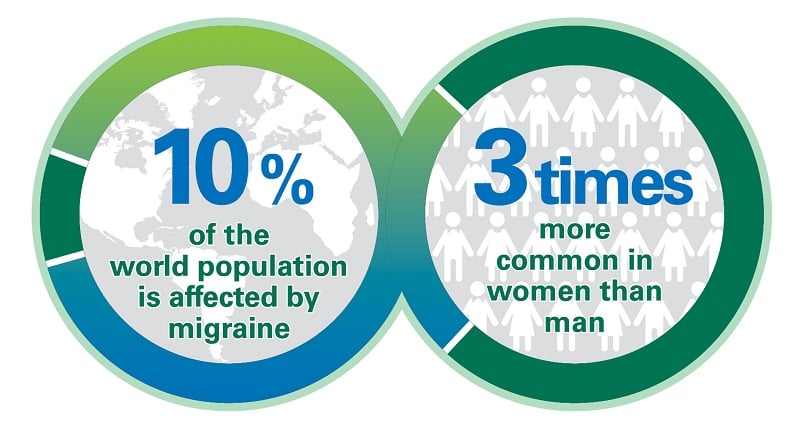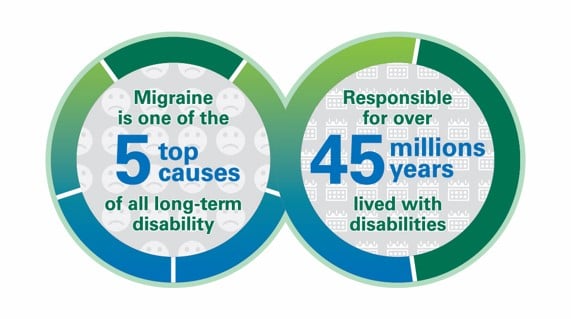About migraine
How to know if you have a migraine? What are the typical migraine symptoms? When to see a doctor?
Clinical features of migraine
- Migraine is a chronic, complex neurological disorder that manifests as recurrent attacks of moderate to severe headache pain lasting 4–72h.1
- The headache is typically unilateral, has a pulsating quality, is aggravated by routine physical activity and is associated with nausea and/or sensitivity to light and sound.1
- In migraine with aura, the headache phase is preceded by reversible focal neurological symptoms, often visual or sensory.1
- People who experience frequent migraine attacks are considered to have either episodic migraine (1–14 migraine days per month) or chronic migraine (≥15 migraine days per month for > 3 months).1
The migraine epidemiology
Migraine is a widespread condition linked to considerable disability levels and is often under -diagnosed and undertreated.2 Globally, approximately 10% of the population is affected by migraine with a higher prevalence among individuals aged 20–50 years2,3 and nearly three times more common in women than men.4

The migraine burden
Migraine imposes a substantial economic burden on patients5 and their families as healthcare costs are significantly higher for a family with a migraineur than for a non-affected family.6
Migraine exerts a substantial impact on individuals, families, and society at large. Migraine is one of the top five causes of all long-term disability.7 According to a study based on the Global Burden of Disease data, it was estimated that migraines were responsible for over 45 million years lived with disabilities.8

Check if it is migraine
A migraine tends to be a very bad headache with a throbbing pain on 1 side of the head. You may get other symptoms just before a migraine, such as:
- feeling very tired and yawning a lot
- craving certain foods or feeling thirsty
- changes in your mood
- a stiff neck
- peeing more
You may also get warning signs you're about to have a migraine (called an aura), such as:
- problems with your sight, such as seeing zigzag lines or flashing lights
- numbness or a tingling that feels like pins and needles
- feeling dizzy
- difficulty speaking
Aura symptoms should not last for longer than an hour. Migraines usually last between 2 hours and 3 days, with some symptoms (such as feeling very tired) starting up to 2 days before the head pain starts and finishing after the headache stops. The frequency of a migraine varies from person to person. Some people may have one migraine attack per year, while others may have them once weekly or even more often. On average, most people experience migraine attacks two to four times per month.9
See a doctor if:
- your migraines are severe or getting worse, or lasting longer than usual
- you have migraines more than once a week
- you're finding it difficult to control your migraines
Treatment of migraine
Migraine treatments include:
- painkillers (commonly non-steroidal anti-inflammatory drugs such as ibuprofen, paracetamol, naproxen)
- medicines called triptans
- medicines that stop you feeling sick or being sick
Your doctor could prescribe a combination of medicines to find something that works. A doctor may also recommend making changes to your lifestyle to help manage your migraines, such as eating at regular times and drinking less caffeine.
References:
- Headache Classification Committee of the International Headache Society (IHS). 2018;38(1):1-211.
- Lipton RB and Bigal ME. Headache. 2005;45(Suppl 1):S3-S13.
- Walter K. JAMA. 2022;327(1):93.
- Steiner TJ et al. J Headache Pain. 2019;20(1)57.
- Burch RC et al. Neurol Clin. 2019;37(4):631-649.
- Stang PE et al. Am J Manag Care. 2004;10:313-320.
- GBD 2016 Disease and Injury Incidence and Prevalence Collaborators. Lancet. 2017;390(10100):1211-1259.
- Stovner LJ et al. Lancet Neurol. 2018;17:954–976.
- Ferrari MD, Goadsby PJ, Burstein R, et al. Migraine. Nat Rev Dis Primers. 2022;8(1):2.
